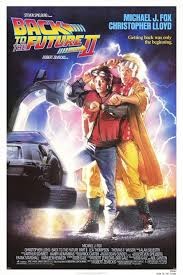
Growing up, and even now to this day – one of my favourite movie lines of all time has to be from the ultimate sci-fi comedy classic Back to the Future.
‘Wait a minute Doc. Are you tellin’ me you made a Time Machine?…out of a Delorean?!?’
Given the current antics in the run-up to the selection of the Republican candidate in the US Presidential Campaign, I can just hear someone from 1985 saying ‘Tell me the future boy. Who’s President of the United States in 2016?’
‘Donald Trump!!’ ’Donald Trump – the millionaire??!! Only time will tell…
But what is perhaps most amusing now about the movie – this year in particular – isn’t the clever scripting or even Christopher Lloyd’s crazy mad scientist hairdo. What’s most amusing is to see how our 1985 predictions for 2015 turned out to be, and then guessing what we think the consumer world will be like in 2045.
After all, 2015 is the year that is the setting of “the future” in Back to the Future 2.
There is a nearly endless display of predicted nifty gadgets that never quite came to be. Flying cars, hover boards, and self-drying/self-fitting jackets are among some of those that have yet to come to fruition.
However, Google’s self-driving cars, Smart TV’s, and Siri are very close to what was prophesized in 1985. I’m sure everyone who has seen the movie can name off a few of their favourites.
All of this then begs to question. Given how right or wrong we were about 2015, what do we now think the consumer environment will be like in 2045? What are YOUR predictions for the future consumer market?
Doug Stephens, author of The Retail Revival and Founder of Retail Prophet, thinks he knows.
Stephens believes we will enter into an era of what he has dubbed The Replenishment Economy. And in this era, the consumer no longer makes the routine product decisions with basic items such as food, toiletries, and cleaning products, but rather it will be our smart technology that will make these decisions for us.
A few examples of this would be laundry detergent or milk (or beer). In the future, Stephens believes our refrigerator or washing machine will have the capability to know we are low or out of milk and detergent – and will then also have the capability to order those products online without us even having to think about it.
To most consumers, this would be a dream come true. Less trips to the shops, more time for other things.
But to marketers and businesses, Stephens foresees challenging times ahead.
Who do you market your product to if our gadgets are the ones making the day to day purchasing decisions? And if shoppers aren’t in the store as often (if at all), then how do companies expose shoppers to in-store advertising?
Surely – one would think – technology, software, and devices will advance in such a way that allows for our own personal preferences and input, thereby opening the window for new brands to be added to the preference lists of our ‘at home gadgets’. You see a billboard ad you like – and you simply tell your device to put that on your ‘Like’ list.
Back to Future 2In Back to the Future 2, the movie writers got plenty of things wrong that could be considered laughable now. Jaws 19 is a long ways off (Rocky 7?), Nike hasn’t developed the self-tightening laces yet, and Biff’s ‘Pit Bull Hover board’ remains a dream (or nightmare depending on who you ask).
But there is one main theme in all of the Back to the Future movies that remains constant and, short of global tragedy, will only become more prevalent as time goes on.
And it is the urban Town Square environment and the tendency of people to come together to socialise and experience all the city has to offer.
And as our increasingly smart and digitalised gadgets grow in sophistication, we will surely be able to have some sort of input and control into how our gadgets prioritise brands.
In the first Back to the Future movie, as they prepared to fly off in a revamped Delorean and zip off 30 years into the future, Doc Brown quipped ‘Where we’re going, we don’t need roads.’
That may be true. We may not need roads in 2045, but marketers can rest assured that marketing targeted in increasingly urban spaces, despite technological advances, will at least have this common ground to rely on for another 30 years.